FUNGI TIME HAS COME!
What can we learn from fungi in regard to the ways we plan and build our environment?
Unit 10
Summative Submission
Stage 3
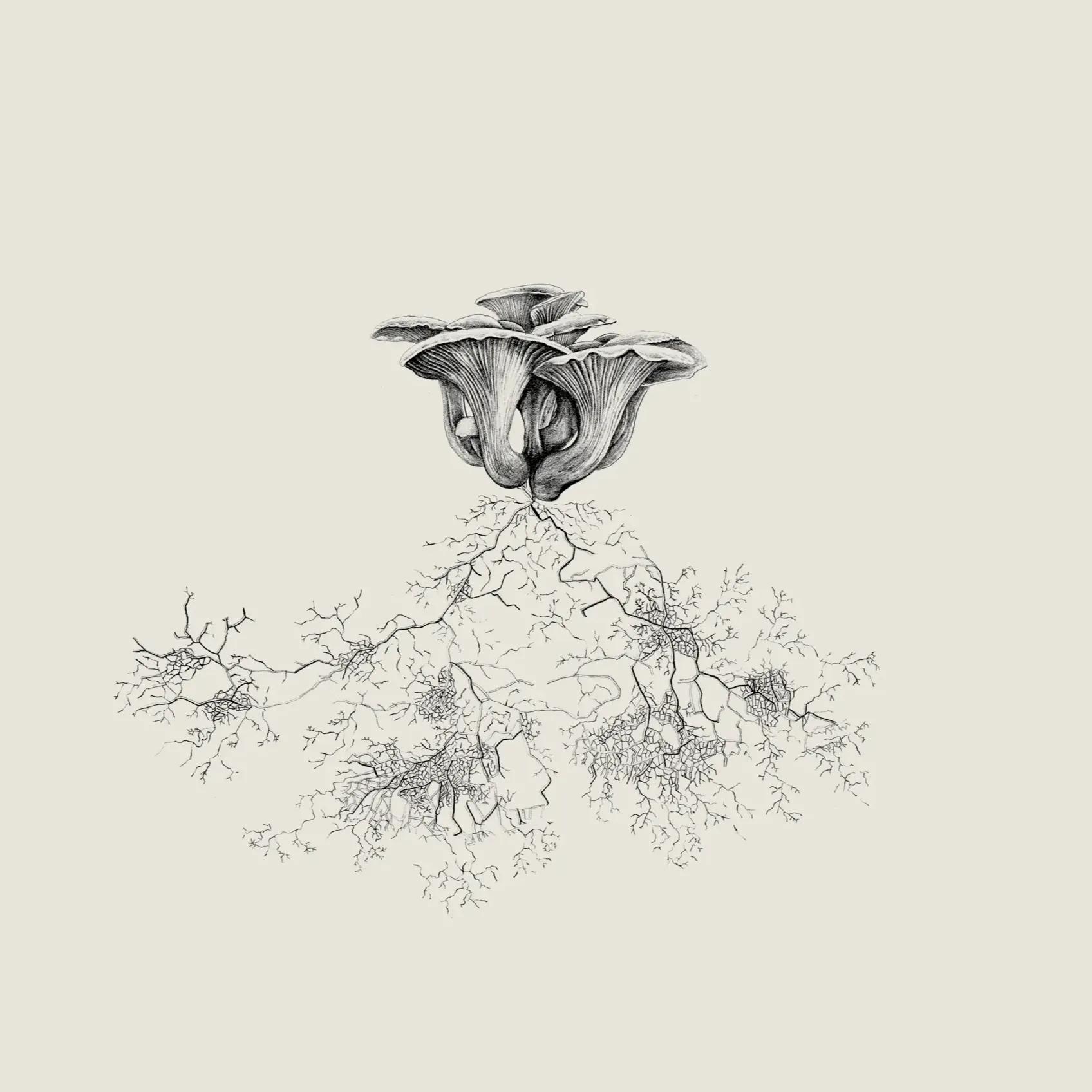
 Elina Dimova
Elina Dimova
MYCELIUM AS AN ALTERNATIVE MATERIAL IN THE BUILT SECTOR


INTRODUCTION content THEORETICAL BACKGROUND | part 1 | p. 4-5 p. 6-8 p. 12- 21 p. 10-11
ANALYTICAL FRAMEWORK
Fig. 1 Nature’s limitless material,
MYCELIUM AS A REGULATORY TOOL
MYCELIUM AS AN ORGANISATIONAL AND FUNCTIONAL PARADIGM IN ARCHITECTURE


| part 2 | | part 3 | p. 22-27 p. 28-34
p. 36
CONCLUSION
material, Mycelium (MONC, 2022)
INTRODUCTION
We encounter fungi in our everyday life - drinking beer or wine, eating bread, cheese or yoghurt, the medicine we take. Fungi bind the whole living world together, unlocking nutritions and powering the Earth’s ecosystem, that will otherwise collapse without them. They are not animals, plants or herbs, neither roots or flowers, but fungi can be part of earth, trees or rotting wood. Mycelium is the vegetative state of fungi and they form the whole underground network of the forest (Rathinamoorthy, 2021).
ate other fields, have not as yet been fully adopted by architecture. The problem is architecture hasn’t really looked into it seriously yet. There is a lot of potential here, architects could be thinking about mycelium structures and mycelium based materials and their uses - as building material, insulation, regulating environment, and even mycelium can help us plan city infrastructures. Part of the value here is that when we mimic biological systems, there is greater chance that we will live in harmony with nature as oppose to destroying it.
While being fundamental and in the centre of life, fungi symbolise the interconnectedness and interdependence of nature. These are characteristics that the science of mycology has been studying since 1800’s when fungi begin to be recognised as their own kingdom (BD Editors, 2018). As the field of mycology continued expanding, so did the understanding of the importance of fungi and how broad and diverse their kingdom is. Agricultural mycology emphasises on making effective use of fungi in commercial crops and how to control them. Toxicologists focus their studies on mushroom compounds and how they can affect other organisms (BD Editors, 2018). The design world has only recently started researches of the potential and application of fungi—based products. However, these insights that are starting to perme-
In response, I am going to examine the potential for mycelium to be used within architectural practices. I will attempt to achieve this by firstly giving some context and recent research in fungal and mycelium studies. Then examine three main themes - why we should use mycelium as a building material. How to literally use fungi with regulatory purposes in order to decompose waste. Then I will take further the idea of closed-loop model of economy in order for architects to switch to designing regenerative architecture. And how can we use fungi processes and their structure when designing and building architecture, taking examples from how fungi live and exist in nature. I will demonstrate my research by looking into different case studies of how mycelium is applied in the design world, but
4
‘If fungi is the stationary fruiting body, mycelium are the soldiers, the brave ones that search for moisture and nutritions, they are natures glue because they bind everything together, recycle waste and allow fungi to grown and bring new life.’
- Mae-Ling Lokko, 2018
also examples of fungi behaviour in nature. This thesis aims to propose that the architectural profession and research should investigate in full the potentials mycelium and fungi can suggest to architecture. In order to shift to a sustainable use of materials and a closed loop economic architecture approach. From small scale material application through alternative pollution regulation tools, to models organising our cities, fungi can serve architecture as a new source of information for a sustainable and socially positive approach.
FUNGI TIME HAS COME:
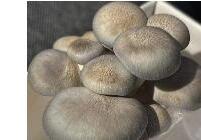
What can we learn from fungi in regard to the ways we plan and build our environment?
My aim is to look into mycology with a solution-based approach, to tackle the lack of knowledge through a framework that is technical, pragmatic and promotes ecological solutions. I want to find the meeting point between mycology and architecture in different applications.
Fig. 2 Blue oyster mushroomspersonal mycelium experimentation
THEORETICAL BACKGROUND
The exploration of fungi begins of the appreciation of how incredibly diverse these species are. To give a perspective of our limited knowledge of fungi - There are 15 million species estimated to live on Earth and 6 million are estimated to be fungi (McCoy, 2016). Only 1.5%, or around 75, 000, of all fungi has been classified to date and only 100 species have been integrated into human activities (McCoy, 2016). The life on Earth is dependent on fungi as they are responsible for redistribution of nutrition throughout the world and for more than 90% of all decomposition (McCoy, 2016). The whole ecosystem is designed and held together by fungi and this process started around 2 billion years ago, when fungi were one of the first organisms existing on Earth. They built the way for all the plants and animals, healed, supported and evolved all the life on Earth (McCoy, 2016). It is fair to say that we owe the world to them. Having such an important role in the history of the evolution of the life on Earth, it is incomprehensible why fungi is disregarded.
It was only 1707 when Carl Linnaeus, one of the first humans to classify mushroom, compared the habits of mushrooms with these of animals and he claimed they were similar to worms (McCoy, 2016). It was the second half of 20th century, when scientists still designated fungi as plants that are not evolved enough and cannot photosynthesise (McCoy, 2016).
In the year of 1959, this big error was adjusted when Robert Whittaker identified fungi in their own category, Queendom Fungi (McCoy, 2016). After this acknowledgement, mycology was born. Scientist started researching with bigger interest the properties of fungi, the conditions needed for their growth and spreading. In the beginning
of 21st century fungi, and in particular mycelium, started slowly entering the design and build world.
Today, one of the biggest challenges we are facing, is to transform our current economy into an eco-friendly and self-sustaining system (Karana, 2022). Bio-based materials have no environmental footprint throughout their lifecycle. Eben Bayer and Gavin McIntyre invented a new degradable biomaterial and developed the idea of mycelium packaging, suggesting that mycelium can be moulded into any shape (EPO, 2019) (Ecovative LLC, 2022). Most of the materials that we use such as plastic are man-made, so we control the production and thus the properties of these materials. When it comes to mycelium, we should be aware that the properties of mycelium itself can vary significantly and it depends on the growth conditions (Islam et al., 2017).
Mycelium’s composition is natural - natural polymers such as chitin, cellulose and proteins (Agosti, 2022). It offers unlimited potential for recycling organic waste. One network of mycelium can occupy around 10km^2 underground and it has been identified as the largest living organism on Earth (Agosti, 2022). Mycelium based materials can be composed either by pure mycelium or composite bonded by the inter winded network of the growing mycelium.
6
‘Mycelium based materials utilise natural fungal growth as a low energy bio-fabrication method to up-cycle abundant agricultural by-products and wastes into more sustainable alternatives to energy intensive synthetic construction materials’
- Agosti, 2022
So, mycelium composites have fundamentally customisable properties which are based on the structure of their substrate1, or the other material they are “feeding on”. On a small scale, mycelium based material can replace timber, foams and plastic that are used in insulation, panels, flooring. They can outperform traditional construction materials with their combined properties - low thermal conductivity, high acoustic absorption and are flame retardant (Agosti, 2022).
According to the United Nation’s ‘Global Status Report for Buildings and Construction’ conducted in 2020, the building sector is responsible for 38% of all energy-related CO2 emissions (Almpani- Lekka et al., 2021). In order to reduce this number, the building industry is looking for holistic solutions that can contribute towards increasing the energy efficiency during the construction process, materials with life cycle that support circular economic and energy flows. That means that the built industry should entirely shift the construction process of extracting raw materials from nature that end up being disposed to using low-impact materials, such as mycelium based materials, that can be relocated for another building resources (Almpani-Lekka et al., 2021).
We, as architects, aim to understand the importance in finding value in things that are forgotten or ignored. Nature has served us as an endless source of inspiration and has offered optimal solutions to innumerable challenges of life and survival (Mazzoleni & Price, 2017, p. 25). Together with the technological development and the knowledge we have obtained, the human race should have greater understanding and use of nature and natural resources. But why are we not taking advantage of 1. Substrate is the medium that offers nutrition, moisture and energy to the mycelium in order to grow and allow mushrooms to fruit.
the advanced understanding we have about nature and use it to build a better world, a world were pollution is not a problem, where we are not relying on non-renewable natural resources or man-made materials? Why does not the human race redirect on a path where all organisms live in harmony? We act as if we are not part of nature, as if we are superior to nature to such extend that we see all other entities such as animals, plants and minerals as resources that should be utilised for the benefit of humankind.2 In order to move away from this way of thinking, we need to change our understanding of our place in nature. We should shift from the anthropocentric approach to a more ecocentristic - where the essential value of all living organisms is as important as the natural environment. Because we are part of nature.
Humans are not the owners of the Earth but rather part of it. We are part of nature, the same way trees, animals and everything living is. And we are here to live in harmony together, to learn from each other and help each other.
To respond to these challenges, regenerative design aims to focus urban projects that promote positive impacts, suggesting social and ecological systems to co-evolve and thrive (Cole, 2012), (Brown et al., 2018).
7
“Humankind has not woven the web of life. We are but one thread within it. Whatever we do to the web, we do to ourselves. All things are bound together. All things connect”
- Chief Seattle, 1854
2. This is the definition of the philosophy of anthropometrics.



Theoretical background


How an industrial symbiosis may be beneficial and can it work the same way as mycelium communicates, survives and lives in nature’s ecosystems?
My dissertation is inspired by the pressuring urge that it is time to start thinking about the world and planet we live on all together, shifting our focus on conserving nature, we should build in harmony and preserve the nature and natural resources we use.
I want to examine the benefits and disadvantages of mycelium and how can mycelium help us move towards a more regenerative design. I aim to critically asses all three different themes and the case studies based on the following framework. How can mycelium influence architecture sector towards a more sustainable, ecological approach?
When we talk about sustainability is important to outline that a building itself should be sustainable the way it is build but also one should support sustainable pattern of living.
Regenerative design focuses on adaptability and emerges towards reliance and supporting flourishing eco-systems. Raymond J Cole underlines that a key aspect of regenerative design is the recondition and emphasis of the ‘co-evolutionary, partnered relationship between human and natural systems’ and the importance of projects location and place (Cole, 2012).


On the other hand, how applicable is it to shift and focus on bio-based materials?
Can the industry use it based on the knowledge we have or do we need to develop a new approach?
These are the questions I have based my criteria on for assessing the different themes.
11
MYCELIUM AS AN ALTERNATIVE MATERIAL IN THE
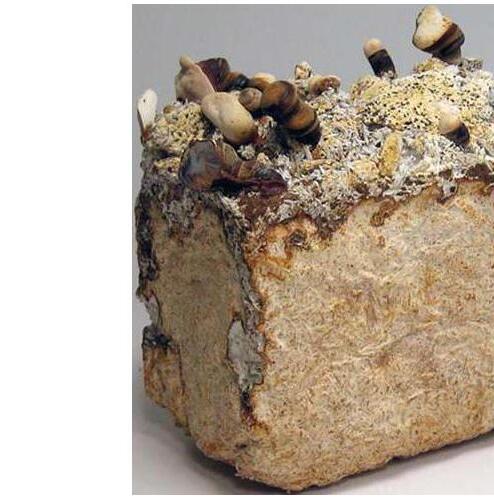
12 | part 1 |
BUILT
Fig. 3
In this section, I will look into the possibilities that mycelium composites can offer to the build industry and what are the benefits and restrictions of using mycelium based materials.
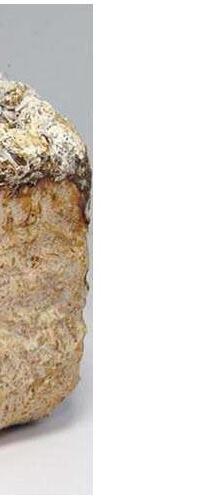
13
BUILT
SECTOR
(Ostapenko, 2020)
MYCELIUM AS AN ALTERNATIVE MATERIAL IN THE BUILT SECTOR
As a response to the current economic and environmental crisis we are facing, there is an urgent need to explore more low-energy and renewable bio-materials. Most of the common used materials in the construction industry end up polluting nature by spending longer time at landfills than they do in the form of a building (Dahmen, 2017). This continues cycle of extractive consumption that increasingly contributes negatively to the environment and our well-being and health is a sign that we need to shift our focus on developing flexible, radically biodegradable and regenerative materials (Dahmen, 2017).
Moving towards a regenerative approach, we should change the anthropocentric approach we have to materials extraction and treating environments, towards a more ecocentric, where we value the nature and co-live in harmony with it. For example, instead of extracting materials, we may focus on growing them. A sustainable design is one that not only reduces the impact on the environment but also contributes increasingly positive on surrounding environment.
Mycelium is a very accessible example for a bio-composite material because it has the great characteristic to grow in any agricultural waste by gluing smaller pieces together. Another key beneficial factor is that mycelium takes the structural properties of the substrate it is feeding on, which makes mycelium based materials flexible, adaptable and customisable.
It can be used simply in insulation panels, cladding or finishes and it shows promising results when tested for acoustic qualities, thermal conductivity and air filtration. Different substrates such as hemp, wood sawdust and other agricultural waste materials combined with different strains of mushroom mycelium, results in mycelium bio-composites with varying structural integrity, density and strength.
Researches on mycelium composites are extended to tests in load-bearing material applications too. They can also be approached as living material, where nature is invited into a build project, bringing it to life as it hosts in live organisms. The process of growing can be stopped and the mycelium can be moulded in the form of bricks that can even be treated and compressed for even higher strength thermal conductivity and waterproof results.
I will examine three recent projects that use mycelium composites in different ways in order to adapt the material and the structure to its purpose and context.
14
Mycelium mockup is an installation produced by AFJD Studios.3 It explores the possibility of replacing polystyrene foam with bio-composed mycelium. The living material was moulded into bricks and it continues growing after being assembled as a wall.4 After a week mushrooms started growing irregularly onto the wall. I think this is a great representation of how working with living materials offers the opportunity to welcome ecologies to a building. The built world and nature should co-exist and life together. It is also an argument of how we need to shift our perspective from the forms we are used to build from such as bricks, and allow the material we are working with to take the form and size that is most efficient structurally for its purpose and context.

During the exhibition, some of the mushrooms were harvested and served to the visitors and the rest of the mushrooms were consumed by the mushrooms themselves which is a representation how organic matter is part of this life cycle within an ecosystem.


15
3. Mycelium Mockup is part of the They Grow Without Us two-year research project (Frid-Jimenez, 2015).
4. The individual blocks were holding together the wall into a monolithic living structure due to the chitin’s great property of gluing together the substrate.
60 Mushrooms and Regenerative Design
Figure 5. Above: Chitin bridges between individually moulded blocks, producing monolithic structure. (Photo courtesy of AFJD. Reproduced with
Fig. 5 (above) The wall produced edible oyster mushrooms that were cooked and offered to the visitors. (Frid-Jimenez, 2015d)
Fig. 4 (above) Detailed drawings of the Mycelium Mockup wall. (FRID-JIMENEZ and DAHMEN, 2015b)
Fig. 6 (above) During the installation, the wall produced edible oyster mushrooms. (Frid-Jimenez, 2015a)
The exhibition was organised and arranged in a way that shows the whole life cycle of mycelium based materials. The living wall that is self gluing as the exhibition continues, the mushrooms that were harvested
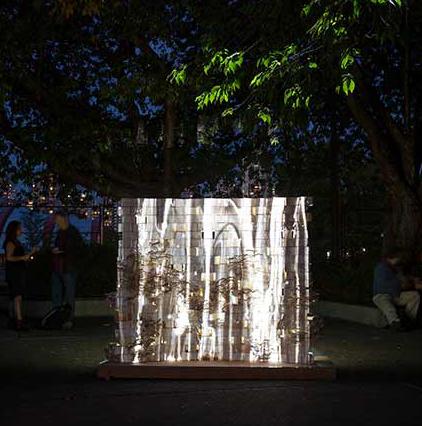
are representing the benefits that mycelium offers. A pile of broken bricks was exhibited, showing the state of decompositions, this material can be returned to the local environment as organic mater. The wall was used to project a video showcasing the process of production but also representing the tension between nature and human kind and man’s will to control nature and natural processes.
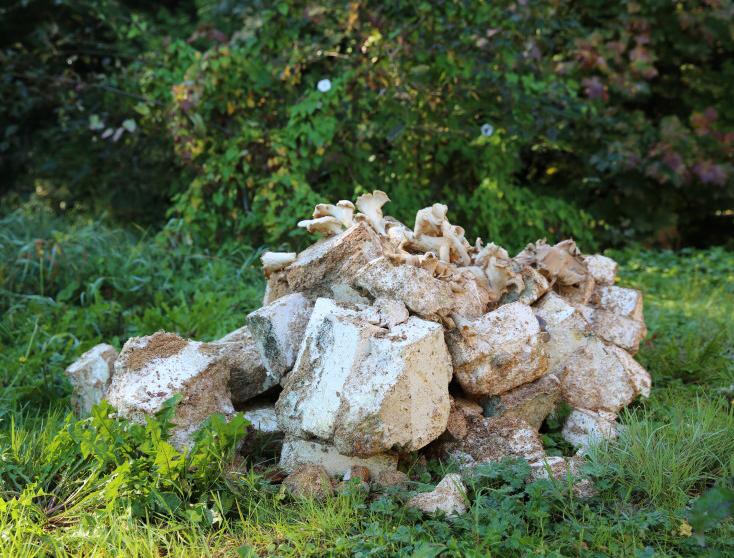
So, the installation can offer an overview of the future where we learn how to adapt biological processes and harness them in order to create buildings responding to the needs of human inhabitants but also the contextual natural environment. Mycelium composites adapt to the substrate, thus the environment it grows in, glues the material together, meaning no toxic or synthetic binder needs to be used in the building process.
As investigations continue, architects started testing how would this material adapt onto a bigger scale, but also how can we use the properties of the mycelium to make stronger bricks that can play the role of structural elements.
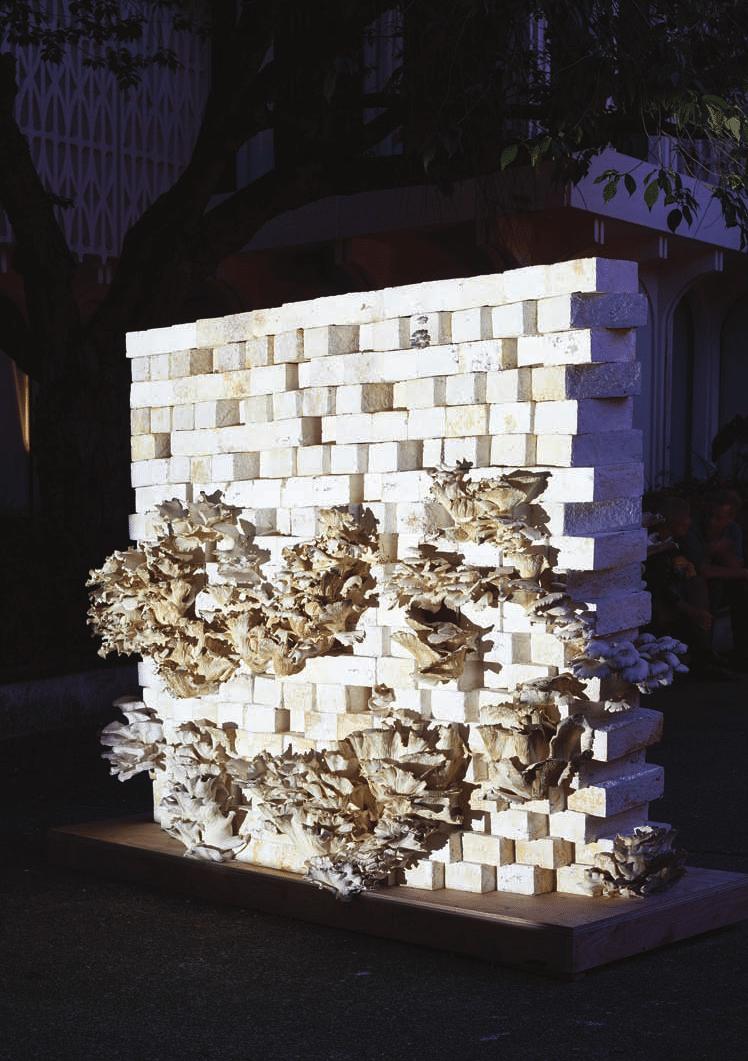
16
Fig. 8 (above)Video presentation (Frid-Jimenez, 2015c)
Fig. 9 (above) Mycelium bricks pile(FRID-JIMENEZ and DAHMEN, 2015a)
Fig.7 (below) During the installation, the wall produced edible oyster mushrooms. (Frid-Jimenez, 2015a)
In 2014, the architecture company, The Living, designed a 13-meter structure, The Hy-Fi 5 This is the first large scale architecture project using mycelium grown bricks (Benjamin, 2014).6 The bricks are low in energy, organic and biodegradable. They consist of waste from corn crops and fungus.7 After the structure was disassembled, the bricks were composed and the resulting soil was returned to the local community gardens. This makes the whole project carbon positive. The structure was calculated to withstand the wind and instead of one stand-alone chimney, three were woven together (Fig. 10).8 The resulting structure can resist over 65 mph wind and the bricks can carry this force on their own. However, the scaffolding planks are remaining in place to limit the amount of movement in the wind (Figure 12 and 13). After three months of cultural events, the struc ture was disassembled,
the brick composted and the resulting soil was returned to local community gardens. These are very promising results and present the mycelium as a solution for a fully biodegradable material. But it is important to note that this is a living material, so when exposed to changing weather conditions, it will start decaying.9 If the mycelium bricks are in contact with the ground, they will decompose in about six weeks.10 The co-founder of MycoWorks, Philip Ross, stated that mycelium bricks have survived east coast winter without touching the ground and with no additional coating (Critical Concrete, 2018). On the other hand, they may shrink or swell, depending on the weather condition, but as it is organic mater, they can be dried out or replaced and can last up to 20 years. When compared to concrete, a mycelium brick is stronger relative to its weight.11
5. The technique for mycelium composite material was first developed by Ecovative in 2007, and was used only for packaging (Benjamin, 2014).
6. The Hi-Fy consisted of 10 000 bricks in total (Benjamin, 2014).
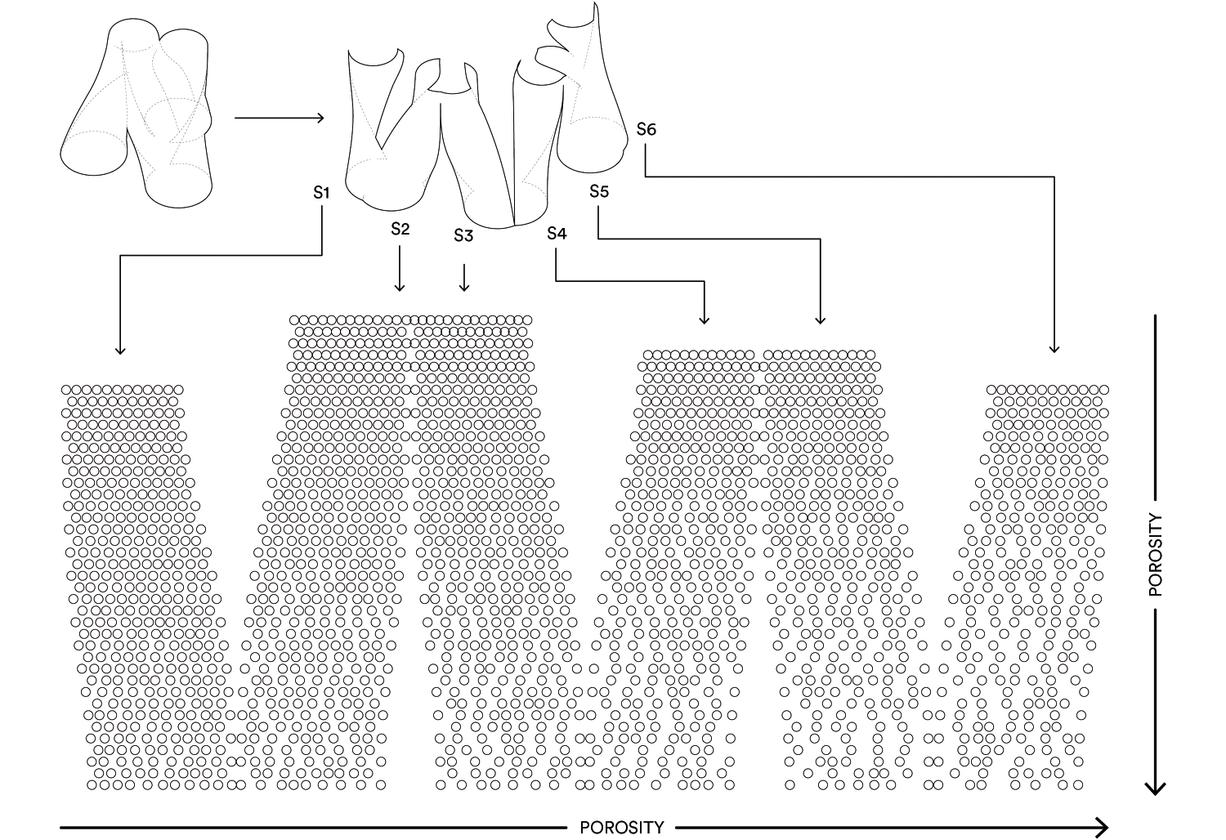
7. The bricks were grown in 5 days in 3 different sizes in order to fill any length without having to cut the bricks (Benjamin, 2014).
8. The bricks strength was tested and from the results engineers calculated that the design would remain structurally sound at 13 m (Benjamin, 2014).
9. Overtime their water resistance may decrease.
10. Time before decomposition depends on the substrate and mushroom stain.
11.
17 Mycelium as an alternative material in the built sector
But mycelium brick’s compressive strength of 30 psi cannot be compared to the 4000 psi of a concrete block (Critical Concrete, 2018).
Figure 10 (above) A gravity-defying effect with lightweight brick construction (Graves, 2014a)
So, in terms of its structural qualities, mycelium has not yet been developed and researched well enough and cannot outperform concrete blocks or traditional bricks. As I already mentioned, when we are working with materials that are literally alive, we need to use this as an advantage and allow the mycelium to grow in a convenient for its properties shape.
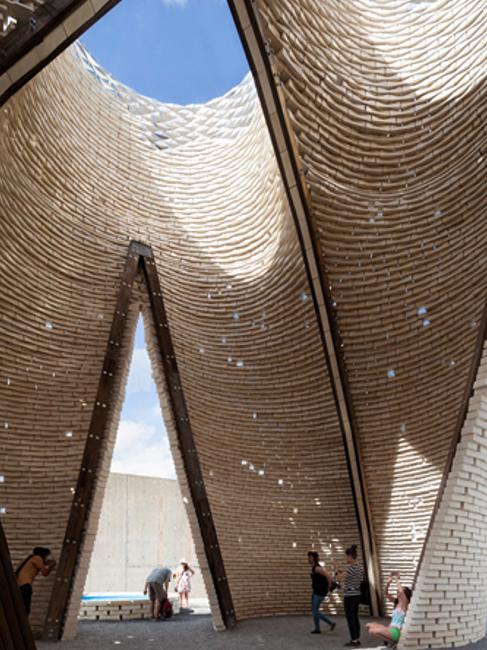
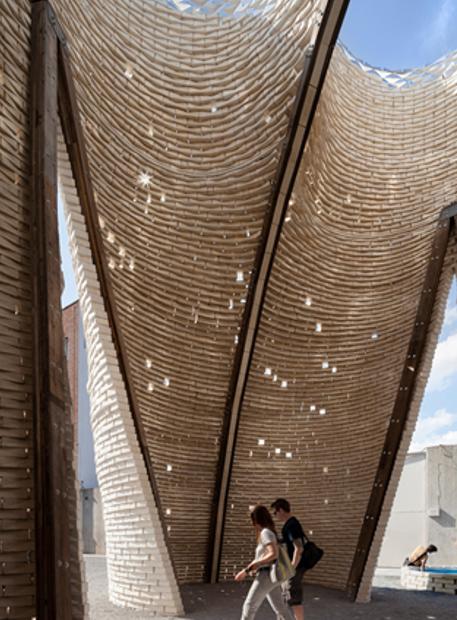
Most of the projects exploring mycelium are taking a common tectonic approach - constructing from modular bricks, prefabricated components or assembled elements systems, resembling well known by the building sector masonry and stone construction logics (Dessi-Olive, 2019). There is a need for alternative construction logics and uses for materials based on mycelium bonds.

18
Fig. 12 and 13 (left and below) Inside the Hy-Fi, showing the supporting scaffolding planks (Graves, 2014b)
Fiig. 11 (above) External facade of the Hy-Fi (Graves., 2014)
Monolito Micelio is a pavilion based on a monolithic mycelium construction methodology, delivered after research and tests on smaller scale prototypes (Dahmen, 2017).12
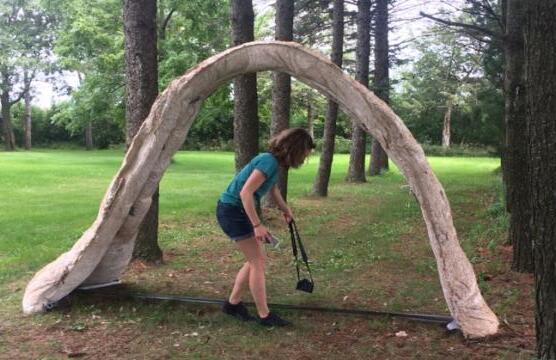
The final design closely resembled a British-Gothic vault and consisted of orthogonal exterior surfaces that were in contrast with the interior curved and vaulting surfaces (Dessi-Olive, 2019).13 The structure was standing thanks to the reinforcing skeleton that was internal lost-work, a removable formwork system of plywood exterior combined with flexible geotextile interior (Dessi-Olive, 2019).
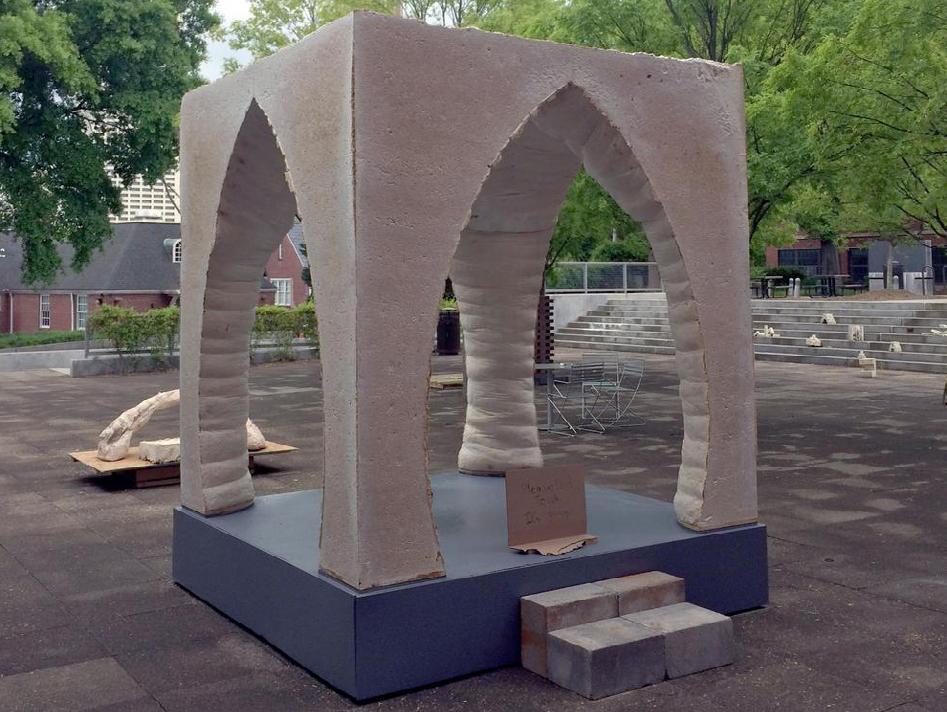
Experiments started with building the Mycoarch Prototype, a monolithic self-grown and self-supoorting mycelium based arch. Result showed that due to inaccuracies to the shape and the rainy weather conditions during the 5-day period of growth, the arch collapsed (Dessi-Olive, 2019).
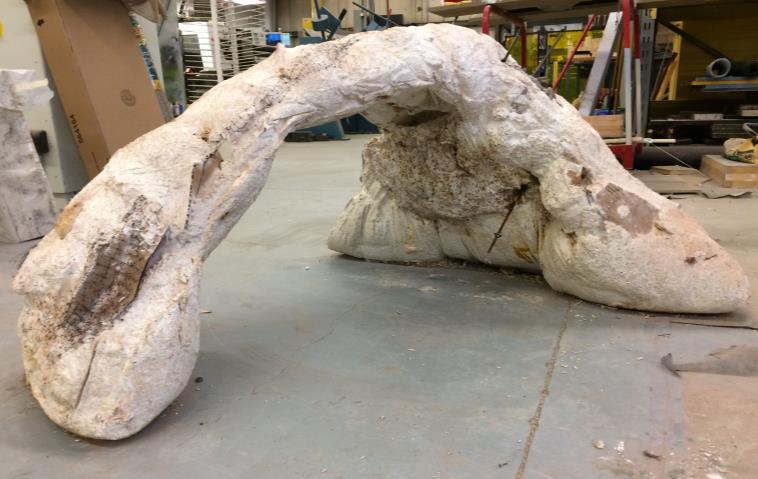
Conclusion is that the process of finding the most efficient form should be more structurally informed, build on from an internal framework. The growing environment is also of big influence and should be controlled based on better understanding of the material properties.
After additional researches into the technique, a second prototype, Thick and Thin, was grown addressing the issue of the first unsuccessful one. During a seminar, as part of an experimental architecture course in the same university, students worked on improving the geometric and constructive functions for structures under compression- only (Dessi-Olive, 2019). The outcome was a double curved form in three dimension that
12.
13. The total mycelium that was input into the structure was 800 kg, and shaped a pavilion 2.5 x 2.5 x 2.5 meters (Dessi-Olive, 2019).
monolithic domes, but did not validate the methods and lighter than concrete, grow-in- place monolithic advantages (and also challenges) of cast-in-place traditional board, plank, or sheeting formwork, as well similar to those perfected by Mark West [23].
Mycoarch Prototype
is self-supporting and the form is especially informed to be stiffer and more stable. The structure is internally supported by a customer internal reinforcing, fibre-based sheet material, cardboard structure (Dessi-Olive, 2019). The biggest success of this experiment is that the cardboard acts as extra food source for the mycelium, so it becomes integrated into the internal reinforcing framework.
The origins of this monolithic mycelium construction experimental project called “Tactical Mycelium” [2 “Mycoarch”, a monolithically grown, self-supporting volume of about 0.4 m3 of mycelium was sourced from membrane, cast over the top of a n active-bent PVC five days, after which it was unwrapped, and let inaccuracies to the shape, and after sustaining preliminary experiment, t he Mycoarch experiment was possible, and motivated additional research
“Thick and Thin” Prototype
Thanks to its partial success, the Mycoarch experiment addressed by a second prototype grown as a part the Georgia Tech School of Architecture , titled developing analytical skills, geometric and constructive structures. Participants included undergraduate, graduate, the Georgia Tech School of Architecture. M onolithic possible means of constructing funicular shell structures material approaches, compared to previous component of observations made during the Mycoarch experiment, small monolithic mycelium shape, its internal formwork, volume of approximately of material sourced
The three primary areas of improvement observed stucturally informed form finding process, using an
The success of the small “Thick and Thin” prototype inspired a collective attempting to scale The “Monolito Micelio” was envisioned self structurally-informed design processes allow for imprecisions to flexible formwork systems visual qualities in surprising, strange, and beautiful. The following section describes the design, growth of the Monolito Micelio bio pavilion which served as a performance barbershop quartet at the School of Architecture at the Georgia Design
Mycelium us ecological advantages over traditional engineered but also have a much lower stress capacity To build with such weak materials, forms that can produce equilibrated material configurations are preferred –stability through geometry, rather than material strength. Assuming imperfections this scale, working toward an optimized form provides a safety factor to success and allows for controlled imprecisions from fabric formwork to produce in the material that are surprising, strange, and beautiful. To generate the geometry a rule-based structurally-informed computational design process was developed
19
It was developed and grown during architecture seminar at the Georgia Institute of Technology School of Architecture in Atlanta (Dahmen, 2017).
”Construction Materials & Technologies for Sustainability”
July 2019 Nairobi, Kenya
THE
Figure 4 : “Thick and Thin” Prototype structure after six weeks of drying. After eight capacity to support the load of a person weighing 75kg
Figure 1 : Mycoarch structure; and detail view showing
Fig.14 (above) Mycoarch Prototype (NOCMAT 2019a)
Fig. 15 (above) ‘Thick and Thin’ Protoype, (NOCMAT
Fig. 16 (above) Monolito Micelio (NOCMAT 2019c)
Mycelium as an alternative material in the built sector
success and allows for controlled imprecisions from fabric formwork to produce visual qualities in the material that are surprising, strange, and beautiful. To generate t he geometry of the pavilion, a rule-based structurally-informed computational design process was developed [Figure 5].
on Technologies
This bond is more sophisticated and stronger than the concrete and steel reinforcing, which never fully integrates and corrodes with time. Another key moment is that the structure was small in scale, thus the environment was easier to control when growing it inside. This is very important as the possibility of mold or other organisms to infect the structure and prematurely terminates the growth, is lower (Dessi-Olive, 2019). The arch was left to dry out for eight weeks and it was able to support a load of 75
Key factor in the performative success of the pavilion is the design and geometry in order to optimise the form.15 The structure was informed by a computational design - a mushroom shaped column was split into four equal parts and rearranged shapping a symmetrical vault shell (Fig.17)(Dessi-Olive, 2019). Materials based on mycelium bonds may have ecological advantages compared to other construction materials but their stress capacity is much lower.
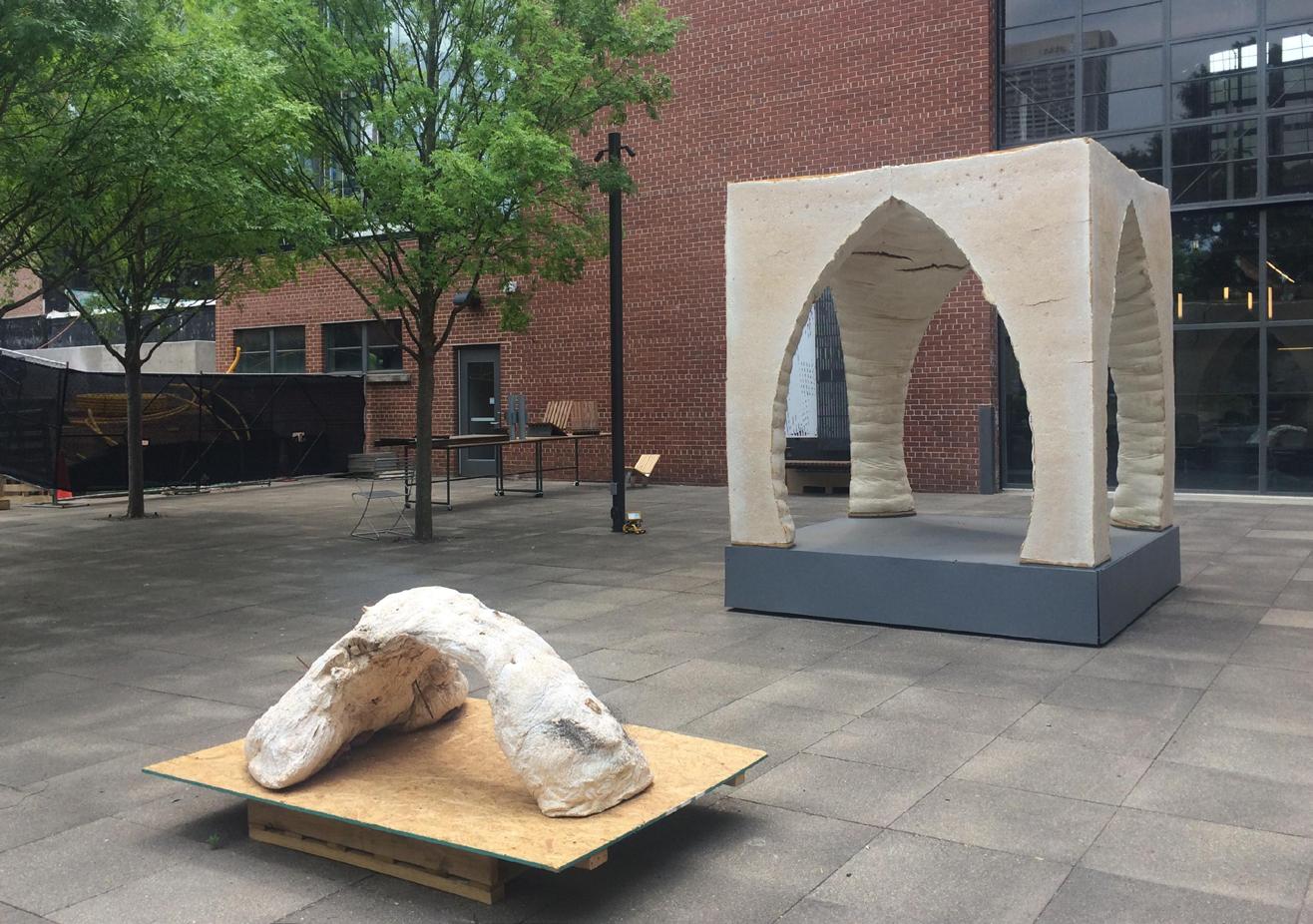

So, the stability of a mycelium structure should focus on geometry and not on the material strength. Equilibrated material configurations can be achieved by compression-only forms (Dessi-Olive, 2019).

All the materials were researched and well informed by previous mock ups and complied with weather conditions and material’s need for ventilation.16
drying. After eight weeks had the weighing 75kg.
only informed the actual project, the Monolito Micelio, but are very important to follow and analyse as they resulted in scaling up the technique that was developed.


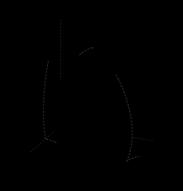
15.
16. Ply-wood sheets were perforated around the structure for support during growth period and for ventilation and woven nylon geotextile covered externally to form the curves (Dessi-Olive, 2019).
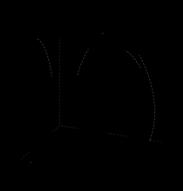
20
14. A volume of around 0.2 m^3 of mycelium was used (NOCMAT, 2019)
The firts two pavilions
Sustainability”
Figure 5: Formation diagram for the geometry of the Monolito Micelio.
Fig. 17 (above) Formation diagram for the geometry of the Monolito Micelio (NOCMAT 2019d)
Fig. 18 (above) After eight weeks had the capacity to support the load of a person weighing 75kg.: (NOCMAT 2019e)
Fig. 19 (above) Pavilion Monolito Micelio compared tot the Mycoarch - from where did the researches start and the final outcome. (Dessi-Olive, 2018)
Building with mycelium does not only require long pre research for conditions of the work environment, for mushroom strain and substrate compatibility. In terms of time applicability, it presents many restrictions and steps that needs to be strictly followed, otherwise the project will completely fail. Mycelium monolithic structures outperform prefabricated elements and modular bricks, but if we look to apply it into big scale buildings, managing the outside environment for the whole period of construction may be only one of the challenges. Even after construction, the material needs to be looked after, as for example, it should not be in touch with the ground or any organic matter as it will start decomposing. Taking into consideration the durability of the mycelium, together with long period of time for research and strictly controlled construction, mycelium does not look like economically efficient material for now.
21
Mycelium as an alternative material in the built sector
In this section, I aim to examine the living material mycelium, this time not as a material composition but rather as a regulatory tool. I will examine mycelium as a suggestion for climate emerging and pollution problems that we are still trying to find the most efficient solution for.

22
| part
2 | MYCELIUM AS A
Fig. 20 (Kellner, 2017)
REGULATORY TOOL

MYCELIUM AS A REGULATORY TOOL
The largest marine spill in the history of the U.S., Deepwater Horizon oil spill or the Gulf of Mexico oil spill, happened in April 2010, and an estimated 1 770 km of shoreline were polluted (Pallardy, 2019).17 Some of the effects are widespread degradation of wildlife habitat and a big negative impact on the whole planetary ecosphere (Stamets, 2020). Years later, oil continues to wash the beaches in many areas and most of it cannot be removed, either because some zones are difficult to reach or because cleaning the submerged oil and organic matter that has accumulated, would actually inflict greater harm on the ecosystem (Pallardy, 2019).


In 2020, journal Nature reports that found fish continues to show evidence of contamination by PAH18 (Pulster et al., 2020). We need a wide range of effort to tackle this complex problem and mycoremediation19 is a potential tool for finding a solution (Stamets, 2020).
In his ambitious TED talk 6 ways fungi can safe the world, Paul Stamets present an experiment he did together with Battle Laboratory in Bellingham, Washington. The purpose of the experiment was to suggest a way to treat a pile that
17. It is calculated that 4.2 million barrels of oil were spilt into the Gulf and this costed approximately of $65 billion but long-term generational consequences can not be fixed (Pallardy, 2019).
18. Polycyclic aromatic hydrocarbons (PAH) is a class of chemicals that occur in or when burning coal, oil, gas, wood, garbage, and tobacco (Centers for Disease Control and Prevention, 2019).
19. Mycoremediation is the use of fungi to degrade or remove toxins from the environment, removing heavy metals from the land by channelling them to fruit bodies for removal
is saturated with diesel and other petroleum as a response to catastrophic events such as oil spills (Stamets, 2008). There were four piles - one was a control pile, one was treated with enzymes, one with bacteria and Paul Stamets inoculated the fourth pile with mushroom mycelium (Sta-
mets, 2008). Why did Stamets decide to treat hazardous waste with mushrooms? Mycelium can absorb oil because it produces enzymes called peroxidases that can break carbon-hydrogen bonds, the toxins produced as a byproduct of using oxygen for respiration (Stamets, 2008). The process continues as the mycelium becomes saturated
24
Fig. 21 (below) Deepwater Horizon oil rig: fire (Pallardy, 2022)
Fig. 22 (above)Oil gathering above the Deepwater Horizon wellhead (Beltrá, 2022)
with the oil and after 6 weeks Stamets’ pile was covered in hundreds of pounds of oyster mushrooms. All the other piles were dead, dark, stinky and less but still toxic to plants and worms, with no hope for any life (Stamets, 2008). What happened in the fungal pile is that these enzymes

Mycology has so far discovered and is continuing researching the various enzymes in fungi, their degradation properties, the properties of toxic substances and it is amazing how the toxic bonds that are heavier are reduced by mycelium enzymes into lighter bonds. This is a potential for staged reduction with subsequent mycelial treatment (Stamets, 2008).
The most exciting part about this case study is that the
’mushrooms released spores, these spores attracted insects, the insects laid eggs, the eggs became larvae, larvae attracted birds and the birds brought seeds. And these vanguard species opened the door for other biological communities. So, this toxic pile became a green berm of life, where a whole new ecosystem was born thanks to the mycelium.’ (Stamets, 2008).
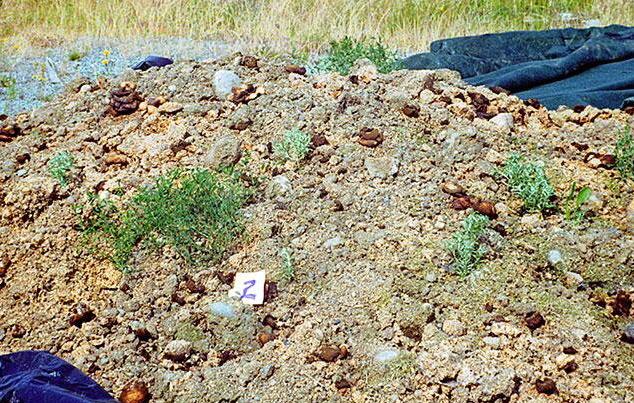
We are not only targeting the polluted soil and decreasing the toxicity but also contributing positively to the environment by offering second chance to ecosystems to start living on that same place.
remanufactured the hydrocarbons into carbohydrates which is fungal sugar (Stamets, 2008). The PAH, decreased from 10 000 parts per million to less than 200 in eight weeks (Stamets, 2008). This means that the toxic bonds are broken down, and with any next generations of fruiting mushrooms, they should continue reducing.
Of course, once an experiment like this is conducted, we need to start asking ourselves questions on how can we make this work on large scale. Most of the experiments on that topic
25
Fig. 23 (below) Oyster mushrooms producing on oil contaminated soil (Thomas, 2020a)
Fig 24 (above) Soil toxicity reduced in 16 weeks, allowing for plants, worms and other species to inhabit whereas control piles remained toxic to plants and worms (Thomas, 2020b)
have been performed on smaller scales and once in a scaled-up system, fungi may not perform in the same way. There is a great gap between laboratory experiments and industrial field, real-life experiments. Bioremidating soil or land is a complex process on itself and we are discussing applying it for big pollutant problems. Also, the scale of pollution we are dealing with today is a lot bigger than the mycelium we have available. Even though it is a fast growing organism, we lack the knowledge we need to develop this system.
The fungi kingdom is not well researched, and when working with fungi, especially on large scale, there are many possible dangers.
There is a high risk that people who work with fungi may developing respiratory diseases or skin irritation, even cancer, according to The Centres for Disease Control and Prevention (CDC) (Seladi-Schulman, 2017).
This risk is even higher when there is lack of widespread availability of mycologically skilled technicians and educators (Stamets, 2008). The public is mycologically uninformed and thus put into a risk too.
On the other hand, the field of mycology is barely funded and neither specialists nor the public can be educated to prevent health and other risks. Paul Stamets is one of the mycologists, that is contributing the most towards the development of such systems and spreading the knowledge. He has organised webinar-like, online courses of education to spread widely methods for mycoremediation training so people throughout the world can benefit. Investing in such hubs will evolve in cross-education and building a whole body of knowledge in the face of the world population, that can be developed over time, addressing the successes and failures. ‘The cumulative knowledge
gained from a centralized data hub could emerge as a robust yet flexible platform that could help generations to come.’ (Stamets, 2008).
Paul Stamets has also initiated experiments that addresses faecal coliform bacteria20 in water and how can we reduce that with mycofiltration21. The fungal mycelium network digest and remove persistent containments not only from soil but also from water. The research project found reduction of the bacteria to be 99% when the contaminated water is filtrated using wood-chip substrate inoculated with mycelium (Turner, 2022).
The rapid growth of population results in increase of the build-up area and increased polluted runoff to water bodies. This limits the access to water for the resident animals and increases the risk of fish deaths. Not to mention we, humans, use these contaminated water bodies as well.
Can the kingdom of fungi suggest a new dimension to Sustainable drainage systems22?
While we look into the possibility to use mycoremidaton and mycofiltration to overcome disasters, we discussed how it can be a challenge to apply it on a big scale. But there is a possibility to find application as integrated mechanism of a cleaning process in the function of a building or a facility. Institutions that can facilitate water storage, that can collect water that gets filtrated using mycelium network and the same fungi can be used to decontaminate the soil. The facilities for these processes can be located in open areas due to health risks for the workers.
20. Faecal coliform bacteria can be present in water due to combined sewer overflows, leaking septic tanks, sewer malfunctions, contaminated storm drains, animal feedlots and can arise during rainfalls or snow melts (US Environmental Protection Agency, 2016).
21 Mycofiltration is the practice of using straw or wood chips that are inoculated with fungi to reduce contamination in water.
22. Sustainable drainage systems replicates the natural drainage of water and is used to improve the water quality in an environmentally beneficial way.
26

Mycelium as a regulatory tool
MYCELIUM AS AN ORGANIZATIONAL AND FUNCTIONAL PARADIGM
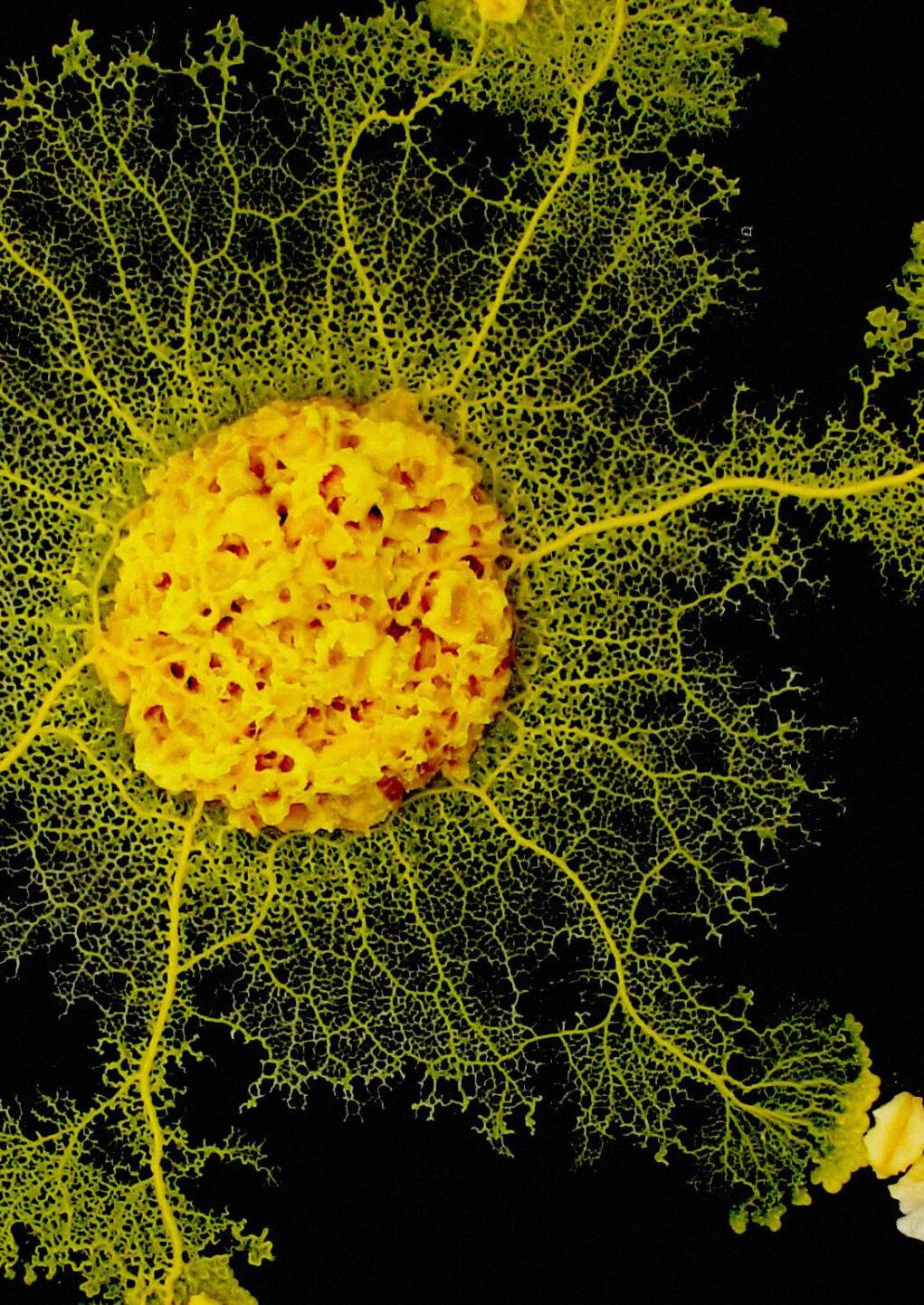
| part 3 |
25 - Yellow
Fig.
IN ARCHITECTURE
In this section, I aim to examine the role of mycelium in the ecosystem as a system of networks and how can we use its structure as a organizational or functional paradigm when building our future cities.

29
PARADIGM
Yellow slime mold, Physarum polycephalum, that designed Tokyo subway system (Dussutour, 2018)
MYCELIUM AS AN ORGANIZATIONAL AND FUNCTIONAL PARADIGM IN ARCHITECTURE
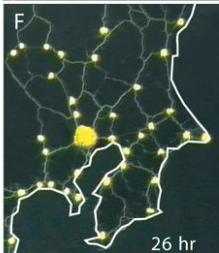


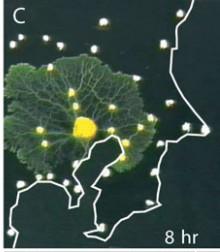
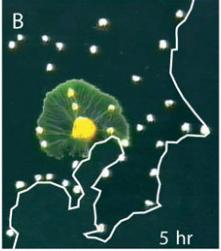

Zooming out from thinking about alternative materials that can substitute the materials we know today, I examined how can we rethink the systems we know for dealing with pollutions, how can we apply methods that are out of the box of the knowledge we already have and apply it in architecture. Let’s zoom out even more and challenge the understanding we have for the approach to architecture, the way we organise our cities, the way we design and plan how a city can function.
In our endeavour to find better approach for designing and fixing the unfixable, we have closed our minds in a box, where we are applying only the knowledge we already have for the existing world. And this knowledge is very advanced, creative and innovative. But what if we try to look outside this box and consider methods that we haven’t yet examined or applied. Where do we look and how do we do this?
In nature every system is in constant dynamic transformation. The concept of co-living and richness of biodiversity is thanks to the interconnectivity between everything in nature. The balance within an organism or an ecosystem is directly connected to the diversity of elements (Mazzoleni, 2017). In architecture, we are focused on separate elements at a time and this allows us to pay attention to details but restricts us from contextualising a model ecologically.
If we take inspiration from biology, we will be able to understand nature and find design examples that are meaningful and useful. We have already been looking at nature, for example leaves and photosynthesis as an examples of how to deal with collecting light and transforming it into energy. This is biomimicry. We have already started thinking on what are the quickest and most efficient ways to reach from one point to another and that is in terms of transport and how we have organised our streets. Engineers spend countless time to design rail systems in the most efficient way, especially in big cities, like Tokyo. Toshiyuki Nakagaki23 decided to carry an experiment using the yellow slime mold, Physarum polycephalum (Sanders, 2010). When surrounded with numerous food sources, the mould initially creates network that goes everywhere, and then continuously refines its network, so the nutritions are distributed most efficiently. For the experiment, oat flakes were positioned in a way corresponding to locations of cities and neighbourhoods in and around Tokyo. Within hours the slime mould had already created a fine mesh and within
30
The study of interconnectivity of individual elements in nature can lead to a significant shift in contemporary architectural thinking.
- Mazzoleni, 2017
23. Toshiyuki Nakagaki is a researcher in Hokkaido University in Sapporo, Japan.
Fig. 26 (above and below) - Slime molds construct networks of nutrient-channelling tubes in 26h (Sand-
a day the pattern was refined strengthened around the central oat flakes so that the tubes carrying the most nutritions grow more robust and redundant tubes are pruned (Sanders, 2010). And this design looked almost identical to the one of the subway rail system of Tokyo. With this example, I want to emphasise that biomimicry can sometimes be achieved by allowing to the natural phenomena we are trying to mimic, to show us itself literally how to design. By understanding how organisms function and live, we can learn not only how to mimic them but also how to deal with them when they are interfere our homes or pose a risk to our health.
We have thought how to build tall so we can save space, how to make the building stand, how to make it function.
Termites regulate ventilation and temperature in their mounds by a complex system of tunnels and openings, and thanks to their fungal symbiosis. We can apply this system on how to design tall building using passive ventilation techniques.
All these individual biometric approaches have already or just found their application in architecture. But this is not enough if we want to reduce CO2 emissions, if we want to design sustainably and preserve the nature around us.
As I already mentioned, now we need to focus on the interconnectivity between these approaches. I am thinking about the future and how we are going to design future building and cities, do we need to change our designing approach in order to organise a circulation for the economy of architecture?
We need a shift in mind-set that allows us to look to ecosystems for inspiration on how we design our cities. Whereas man made systems are very
wasteful, dependant on fossil fuels, use long term toxins, are resistant to change, maximise only one goal and are extractive, natural systems produce no waste, run only on current solar income, use no long term toxins, are constantly adapting to change, optimise a system as a whole and are completely regenerative to their environments (Peer, 2015).
Why do we not mimic the ecosystem and apply it as a system in our cities?
Just like the yellow slime mould designed Tokyo railway system. Can we allow an organism to guide us when designing our cities, not only organisationally, but also functionally?
There is a great example of the Mobius Project developed by Yaniv Peer, architect in Iguana Architects. The Mobius Projects suggests an urban infrastructure system that follows this model and has the potential to manage a large amount of cities biological waste. The project aims to revolutionise the food production industry beyond, in a way that we can manage a large amount of cities biological waste production through a closed loop circular economy in an urban scale (Iguana Architects, 2022). The idea is to take what is of less need, waste, and turn it into what is of great need, locally grown, low carbon nutrition food (Iguana Architects, 2022).
‘This project draws its inspiration from the way in which ecosystems in nature work, where the waste of one organism becomes the input of the next, maintaining nutrients in a perpetual closed cycle with zero waste’.
- Yaniv Peer, 2022
31 Mycelium as an organisational and functional paradigm in architecture
Unfortunately, this project did not get the opportunity to get build. There is another example where a similar system is present.
Kalundborg Symbiosis is the first full realisation of industrial symbiosis with circular approach production between public and private companies in Kalundburg. The system is based on the principle that one waste stream in one company may become a resource for another. While in Mobius, this system was created for food stream, Kalundborg symbiosis is a partnership between different companies that provide, share and reuse different streams of resources - energy, water and materials. What I find really fascinating about such approach is that constant circular movement and exchange of resources, and how a surplus of a resource of one company can add value to another, which benefits both the environment and the economy. We are already partly applying this system in some ways, when different institutions collaborate - for example universities and companies, where knowledge and experience from relevant projects, access to networks and possibility for new projects may be defined as the streams that are being exchanged. And this should be expanded on bigger scale, involving different sectors, identifying fields of potential stream circulation and ensuring continued resource optimisation.
This system is not only socially positive, by creating trust and power of innovation within the community, but is also ecologically
beneficial - the energy supply is carbon negative.
If different sectors join together in symbioses partnerships, what queries would challenge the architecture world?
How should we build to accommodate this new system of collaboration?

And what organism from nature can we study and learn from in order to apply similar system but in the language of architecture? Can we approach the organisation and management of the built environment, building a city as a one whole circular system?
Allow me to elaborate what an amazing opportunity I see if we take this route and why I am so fascinated by natures mechanism of existence and collaboration. This is a place where I speculate and I want to open a discussion on what
Since 2015, the Symbiosis saves the partners and the environment each year:
4 million m^3 of groundwater by using surface water. 586,000 tonnes of CO2. 62,000 tonnes of residual materials recycled. 80% of CO2 emissions in the Symbiosis are reduced.
- Kalundborg Symbiosis, 2020
32
Fig. 27 (above) Stream exchanges in Kalundborg symbiosis (Kalundborg Symbiosis, 2020).
we can achieve if we allowing ourselves to open our eyes and see what is out there and try understand how we can use it.
The task that we face today is to understand the language of nature. The fact that we lack the language skills to communicate with nature does not impugn the concept that nature is intelligent. It speaks to our inadequacy for communication.
- Paul Stamets in Fantastic fungi, 2019
First, we need to start thinking how can we combine all of these different aspects of a city that I have analysed so far - the way we design railway systems and routes, the way we build, how we manage all the waste and unneeded - into one ‘circle’ where everything is interconnected. Everything that is not needed from one institution can be reused by another, where one institution is struggling with resources or knowledge, another institution can help with that. This can all be achieved with architecture, if we rethink the way we plan an urban design, the way we connect spaces, organise and located buildings and pathways and networks between these. And we have a great example in nature that can show us how to do this, we only need to understand it from an architectural point of view and apply it.
Mycelium network has a role in the ecosystem that allows it to interact with other organisms and connects one tree to another allowing them to communicate. This collaboration between plants and fungi is called eco mycorrhiza - trees provide fungi with carbon in the form of glucose, thanks to photosynthesis, and get in exchange nutritions such as phosphorus and nitrogen, which fungi absorb from trees thanks to their specific enzymes (Marino, 2022). This way they talk to each other, sending messages in the form of electric impulses, and if a tree is in danger of pests attack, another tree can increase the competitive environment towards the indentured tree, so it can regenerate further away (Fantastic fungi, 2019).
So, can the role of mycelium as nature’s network be used as a paradigm in the architecture urban design as a circular economy model. We can draw inspiration from this intelligent model of communicating and exchanging and apply it in architecture. We can mimic the mycorrhizal network structure as a model for designing infrastructure projects with an approach to a closed loop circular economy.
We do not need to come up with anything spectacular or completely new. Together with the model for circular approach to production that Kalundborg Symbiosis has put into practice and the inspiration we draw from mycelium’s intelligent model of communicating and exchanging matter, we can start thinking applying this into a bigger scale. Rethinking not only the production but also the organisation and management of the built environment by designing a city as a one whole circular system.
33
A mycelium has more networks than our brain has neural pathways and work in the same way with electrolytes and electrical pulses.
- Fantastic fungi, 2019
Mycelium as an organisational and functional paradigm in architecture
This approach is very socially optimistic. By creating partnerships between institutions, the social value is stimulated and people with similar interest and idea are connected. Benefiting the ecology and stimulating social life, we build an atmosphere where the diverse elements are interconnected, depend to each other and create balance within a city system. Just like in nature.
34


Mycelium as an organisational and functional paradigm in architecture




37
References
Almpani-Lekka, D., Pfeiffer, S., Schmidts, C. and Seo, S. (2021). A review on architecture with fungal biomaterials: the desired and the feasible. Fungal Biology and Biotechnology, 8(1). doi:10.1186/s40694-02100124-5.Beltrá, D. (2022). Deepwater Horizon oil rig: fire. Available at: https://www.britannica.com/ event/Deepwater-Horizon-oil-spill [Accessed 25 Feb. 2023].
BD Editors (2018). Mycology. [online] Biology Dictionary. Available at: https:// biologydictionary.net/mycology/ [Accessed 28 Nov. 2022].
Benyus, J.M. (2002). Biomimicry : innovation inspired by nature. New York, Ny: Perennial.
Bierend, D. (2021). In search of mycotopia : citizen science, fungi fanatics, and the untapped potential of mushrooms. White River Junction, Vermont, London: Chelsea Green Publishing.
Centers for Disease Control and Prevention (2019). Polycyclic Aromatic Hydrocarbons (PAHs) Factsheet | National Biomonitoring Program | CDC. [online] www.cdc.gov. Available at: https://www. cdc.gov/biomonitoring/PAHs_FactSheet.html [Accessed 15 Mar. 2023].
Chief Seattle, (1854), ’Humankind has not woven the web of life. We are but one thread within it. Whatever we do to the web, we do to ourselves. All things are bound together. All things connect’ found in Radical mycology: A treatise on seeing & working with fungi. Portland, OR: Chthaeus Press.
Cole, R.J. (2012). Regenerative design and development: current theory and practice. Building Research & Information, [online], 40(1), pp.1–6, DOI: 10.1080/09613218.2012.617516.
Dahmen, J. (2017). Soft Futures: Mushrooms and Regenerative Design. Journal of Architectural Education, 71(1), pp.57–64. doi:https://doi.org/10.108 0/10464883.2017.1260927.
GROWING VAULT STRUCTURES. In: 18th NOCMAT 2019. Georgia Institute of Technology School of Architecture, Atlanta, GA, USA: 18th International Conference on Non-Conventional Materials and Technologies ”Construction Materials & Technologies for Sustainability” (18th NOCMAT 2019) 24th – 26th July 2019, Nairobi, Kenya, pp.1–12.
Fantastic Fungi. (2019). [Documentary movie].
Frid-Jimenez, A. (2015b). Mycelium Mockup. [online] amberfj.com. Available at: https://amberfj. com/projects/myceilum-mockup/ [Accessed 3 Mar. 2023].
Iguana Architects (2022). THE MOBIUS PROJECT. [online] iguana-architects. Available at: https:// www.iguana-architects.com/the-mobius-project [Accessed 15 Mar. 2023].
Kalundborg Symbiosis (2020). Inspiration. [online] Kalundborg Symbiosis. Available at: https://www. symbiosis.dk/en/inspiration/ [Accessed 15 Mar. 2023].
Khatchadourian, R. (2011). Oil gathering above the Deepwater Horizon wellhead on May 6, 2010. Available at: https://www.newyorker.com/magazine/2011/03/14/the-gulf-war [Accessed 25 Feb. 2023].
Kwinter, S. (1993). Soft Systems. Brian Boigon ed. New York: Princeton Architecture Press, Culture Lab: New York: Princeton Architecture Press, pp.208–27
Lim, M. and Shu, Y. (2022). The Future is Fungi : How Fungi Can Feed Us, Heal Us, Free Us and Save Our World. Port Melbourne, Vic: Thames & Hudson Australia.
Maibritt Pedersen Zari (2018). Regenerative urban design and ecosystem biomimicry. London ; New York, Ny: Routledge, Taylor & Francis Group.
Dessi-Olive, J. (2019). MONOLITHIC MYCELIUM:
Mambrol, N. (2017). The Philosophical Concept of Rhizome. [online] Literary Theory and Criticism.
38
Available at: https://literariness.org/2017/04/26/ the-philosophical-concept-of-rhizome/ [Accessed 3 Mar. 2023].
Marino, G. (2022). Architects of Ecosystems: Will Fungi Shape Our Sustainable Future? [online] www.renewablematter.eu. Available at: https:// www.renewablematter.eu/articles/article/architects-of-ecosystems-will-fungi-shape-our-sustainable-future [Accessed 4 Mar. 2023].
Mazzoleni, I. and Price, S. (2017) Architecture follows nature: Biomimetic Principles for innovative design. Boca Raton: CRC Press, Taylor & Francis Group.
McCoy, P. (2016) Radical mycology: A treatise on seeing & working with fungi. Portland, OR: Chthaeus Press.
Mushroom Mycelium to Reduce Fecal Coliform Bacteria Contamination in Surface Water – CONNECTED HUSKIES. [online] CONNECTED HUSKIES Experiential Learning Opportunities Database. Available at: https://depts.washington.edu/uwbur/ listing/investigating-the-ability-of-mushroom-mycelium-to-reduce-fecal-coliform-bacteria-contamination-in-surface-water/ [Accessed 15 Mar. 2023].
Pallardy, R. (2019). Deepwater Horizon oil spill. In: Encyclopædia Britannica. [online] Available at: https://www.britannica.com/event/Deepwater-Horizon-oil-spill [Accessed 3 Mar. 2023].
Pawlyn, M. (2016). Biomimicry in architecture. 2nd ed. Newcastle Upon Tyne: Riba Publishing.
Pulster, E.L., Gracia, A., Armenteros, M., Toro-Farmer, G., Snyder, S.M., Carr, B.E., Schwaab, M.R., Nicholson, T.J., Mrowicki, J. and Murawski, S.A. (2020). A First Comprehensive Baseline of Hydrocarbon Pollution in Gulf of Mexico Fishes. Scientific Reports, [online] 10(1), p.6437. doi:https://doi.org/10.1038/s41598-020-62944-6.
Sanders, L. (2010). Slime Mold Grows Network Just Like Tokyo Rail System. [online] Wired. Available at: https://www.wired.com/2010/01/slime-
mold-grows-network-just-like-tokyo-rail-system/ [Accessed 2 Mar. 2023].
Stamets, P. (2020). The Petroleum Problem. [online] Paul Stamets. Available at: https://paulstamets.com/mycorestoration/the-petroleum-problem [Accessed 10 Mar. 2023].
Stamets, P. and TED talks (2008). 6 ways mushrooms can save the world | Paul Stamets. YouTube. Available at: https://www.youtube.com/ watch?v=XI5frPV58tY [Accessed 1 Mar. 2023].
Thomas, S. (2020). Oyster mushrooms producing on oil contaminated soil (1–2% = 10,000–20,000 ppm). We do not recommend eating food crops from contaminated soils. Available at: https://paulstamets.com/mycorestoration/the-petroleum-problem [Accessed 25 Feb. 2023].
Turner, R. (2022). Investigating the Ability of Sanders, L. (2010). Slime Mold Grows Network Just Like Tokyo Rail System. [online] Wired. Available at: https://www.wired.com/2010/01/slimemold-grows-network-just-like-tokyo-rail-system/ [Accessed 2 Mar. 2023].
US Environmental Protection Agency (2016). Fecal Coliform | Water Issues| Response to 2005 Hurricanes | US EPA. [online] archive.epa.gov. Available at: https://archive.epa.gov/katrina/web/html/fecal. html [Accessed 15 Mar. 2023]
39
References
/IMAGES AND FIGURES/
Dussutour, A. and CNRS (2018). Despite Its single-celled simplicity and lack of a nervous system, the slime mold Physarum polycephalum may be capable of an elementary form of learning, according to some suggestive experimental results. [Online Image] Quantamagazine. Available at: https:// www.quantamagazine.org/slime-molds-rememberbut-do-they-learn-20180709/ [Accessed 15 Mar. 2023].
Frid-Jimenez, A. (2015a). During the installation, the wall produced edible oyster mushrooms. [online image] Available at: https://amberfj.com/projects/myceilum-mockup/ [Accessed 3 Mar. 2023].
Frid-Jimenez, A. (2015c). The wall functioned as a screen for a series of two channel projections developed by the Studio for Extesive Aesthetics. [Online image] amberfj. Available at: https://amberfj.com/projects/myceilum-mockup/ [Accessed 3 Mar. 2023].
Frid-Jimenez, A. (2015d). The wall produced edible oyster mushrooms, providing a source of food as well as structural support. [Online image] amberfj. Available at: https://amberfj.com/projects/myceilum-mockup/ [Accessed 3 Mar. 2023].
FRID-JIMENEZ, A. and DAHMEN, J. (2015a). Biocomposite blocks add to ecosystem at end of project. [Online image] Online report. Available at: https://www.acsa-arch.org/proceedings/Annual%20Meeting%20Proceedings/ACSA.AMP.104/ ACSA.AMP.104.27.pdf [Accessed 3 Mar. 2023].
FRID-JIMENEZ, A. and DAHMEN, J. (2015b). Detailed drawings of the Mycelium Mockup wall. [Online image] Online report. Available at: https:// www.acsa-arch.org/proceedings/Annual%20 Meeting%20Proceedings/ACSA.AMP.104/ACSA. AMP.104.27.pdf [Accessed 3 Mar. 2023].
Graves, K. (2014a). A gravity-defying effect with lightweight brick construction. [online image] MoMA. Available at: https://www.holcimfoundation. org/projects/hy-fi [Accessed 3 Mar. 2023].
Graves, K. (2014b). Inside the Hy-Fi, showing the supporting scaffolding planks. [online image]
MoMA. Available at: https://www.moma.org/calendar/exhibitions/3664?installation_image_index=26 [Accessed 3 Mar. 2023].
Graves., K. (2014c). Installation view of the exhibition ‘Young Architects Program 2014’. [online image] MoMA. Available at: https://www.moma. org/calendar/exhibitions/3664?installation_image_ index=13 [Accessed 3 Mar. 2023].
IC - NOCMAT 2019 (2019a). Mycoarch structure; and detail view showing unique qualities resulting from flexible formwork. Online academic paper.
IC - NOCMAT 2019 (2019b). The prototype Thick and thin. Image. Online academic paper.
IC - NOCMAT 2019 (2019c). The Monolito Micelio. Image. Online academic paper.
IC - NOCMAT 2019 (2019d). Formation diagram for the geometry of the Monolito Micelio. Image. Online academic paper.
IC - NOCMAT 2019 (2019d). Formation diagram for the geometry of the Monolito Micelio. Image. Online academic paper.
IC - NOCMAT 2019 (2019e). Thick and Thin” Prototype structure after six weeks of drying. After eight weeks had the capacity to support the load of a person weighing 75kg. Image. Online academic paper.
Kalundborg Symbiosis (2020). [online image] Stream exchnages in Kalundborg Symbiosis. Available at: https://www.symbiosis.dk/en/inspiration/ [Accessed 15 Mar. 2023].
MONC (2022). Nature’s limitless material, Mycelium. [Online image] website. Available at: https:// www.monclondon.com/pages/mycelium [Accessed 20 Mar. 2023].
Ostapenko, D. (2020). [online image] Available at: https://www.archdaily.com/949007/mushroom-buildings-the-possibilities-of-using-mycelium-in-architecture [Accessed 20 Mar. 2023].
40
Pallardy, R. (2019). Deepwater Horizon oil spill. In: Encyclopædia Britannica. [online image] Available at: https://www.britannica.com/event/Deepwater-Horizon-oil-spill [Accessed 3 Mar. 2023].
Sanders, L. (2010). Slime Mold Grows Network Just Like Tokyo Rail System. [online image] Wired. Available at: https://www.wired.com/2010/01/ slime-mold-grows-network-just-like-tokyo-rail-system/ [Accessed 2 Mar. 2023].
Thomas, S. (2020a). Oyster mushrooms producing on oil contaminated soil (1–2% = 10,000–20,000 ppm). We do not recommend eating food crops from contaminated soils. Available at: https://paulstamets.com/mycorestoration/the-petroleum-problem [Accessed 25 Feb. 2023].
Thomas, S. (2020b). Soil toxicity reduced in 16 weeks to less than ~ 200 ppm, allowing for plants, worms and other species to inhabit whereas control piles remained toxic to plants and worms. Available at: Soil toxicity reduced in 16 weeks to less than ~ 200 ppm, allowing for plants, worms and other species to inhabit whereas control piles remained toxic to plants and worms. [Accessed 25 Feb. 2023].
41

 Elina Dimova
Elina Dimova










































